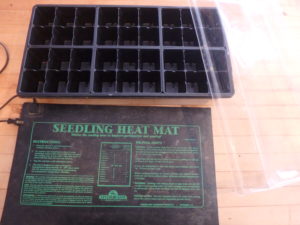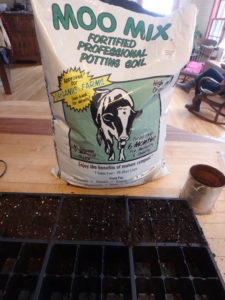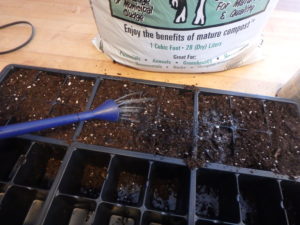Starting Seedlings Indoors: How, When, Where?
Is it time to start seedlings yet? Yes, for a few things: artichokes, broccoli, Brussels sprouts, cabbage, onions and leeks, kale and peppers. Tomatoes I start in early- to mid-April, along with eggplants, lettuce, melons and squashes of all sorts. Root crops are generally started outdoors later on, but I have started beets indoors on occasion for an extra early crop.
If you want a lot of annual flowers, starting by seed can be a big saving. But, as with vegetables, you have to do it just right in order to get plants that resemble the ones you would buy at the garden center.
If I just want a 6-pack of nasturtiums, it is cheaper to buy them as plants than as seeds. A packet of seeds often costs $5 or so, though the FEDCO cooperative sell little packets for just $1.30. Those packets generally contain a gram of seeds, and the on-line catalog tells you how many seeds are in it- usually plenty (or more than enough) for a one-year supply.
Most seeds are good for 3 years. But onions, sweet corn, parsnips and spinach are only good for one year. Peas, beets and Swiss chard are good for one or two years. Flowers vary – experience will tell you, or the seed package will. If you have older seed, plant more seeds – not all will germinate, but some probably will.
To get good looking plants, you need lights. Yes, there are people who start plants on windowsills, but those plants quickly get tall and leggy as they reach for light. If you want to start some lettuce seedlings in late April on a window sill, sure, you can keep them there for a month before putting them outside. But tomatoes? Forget about it.
Buy 4-foot fluorescent lights and hang them 6 inches above your seed flats. As the plants grow, move the lights up to keep them at the right distance. Now there are LED lights made for the same 4-foot fixtures you may already have, and they are supposed to be more effective and less expensive to run. They are available on-line from Gardeners Supply Company. LED lights should last for 20-plus years. I use something called jack chain, which I get at the hardware store, to hang my lights as it is easy to adjust the length of the chain.
I use a biodynamic calendar called Stella Natura (www.stellanatura.com) to guide me when to plant seeds. It uses the sun, moon and stars to determine when optimal dates are for planting. It also gives “black-out” days to avoid. I’ve tested the black-out days, and never plant on them. Sunday, April 8 will be good for starting tomatoes this year, but the 11th to 13th will be black-out days.
Seeds have a built-in heat-sensitive trigger that controls germination. It would be a bad idea for a seed to germinate in January, for example, even if there were no snow. Cold would kill the seedlings. Warm soil tells a seed that the sun is strong, has been for some weeks, and probably will continue to be strong and warm.
You can add bottom heat to your seed flats by buying electric heat mats. They are about the size of a flat, and add a low, gentle heat to warm the starting mix your seeds are planted in. They will speed up germination considerably.
Don’t even think of starting seeds in garden soil. Although I sometimes make soil blocks from compost and peat moss with some added garden soil, usually I just buy Moo-Doo brand planting mix that I put in little plastic 6-packs. I always buy the 6-packs that have the biggest cells available. Some come with 72 compartments to the flat, some 48 and others 36 or 32. I like the 32’s – they have more room for roots.
Seeds are very sensitive to drying out, especially just after they have germinated. To minimize the chances of that, I use plastic covers that fit on the flats. These are clear, allowing light to pass through, but not moisture. Safely stored, these are good for many years. You can save and wash the 6-packs but they are cheaply made and often crack or break, so I don’t bother most times.
Read the seed packets when planting seeds. Lettuce seeds need light to germinate, so just a very fine layer of planting mix or fine vermiculite will do. A big seed like a squash needs half an inch or more of cover. Generally the bigger the seed, the deeper the hole. I use a pencil to make a divot for each seed.
Because the Queen of the Garden is the tomato, I plant 2 seeds in each cell. Usually both germinate. The hard part is then snipping off one of the two. It feels awful to kill a tomato, but growing both in a small cell will result in stunted growth and completion for nutrients. And if the seedlings get too big, I transplant some into small pots.
As plants grow, they quickly use up the minerals that came in the potting mix. I make a dilute solution of fish and seaweed fertilizer and use it to water my seedlings. That’s what nurseries do, although most use chemical fertilizers – sometimes pushing the plants to grow too fast. And since I am not going to use chemical fertilizers, I don’t want plants that expect them.
Starting seedlings is a sure cure for MSB (Mud Season Blues). I love watering and admiring my little tomatoes, and dreaming of them in sandwiches on thick slices of all-grain bread with rich mayonnaise. Sigh. That’s still a long way off.
You may reach Henry by e-mail at henry.homeyer@comcast.net. His website is www.Gardening-Guy.com.





